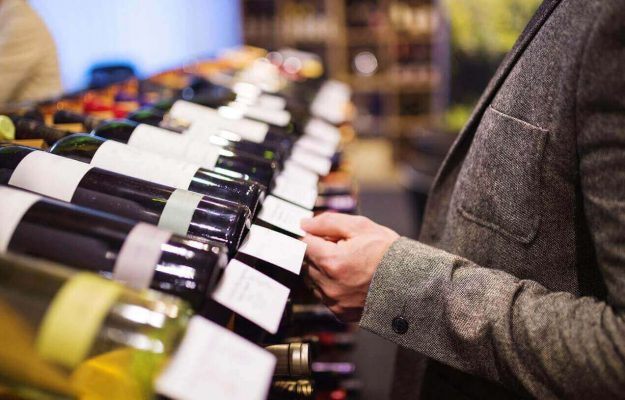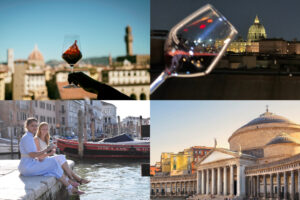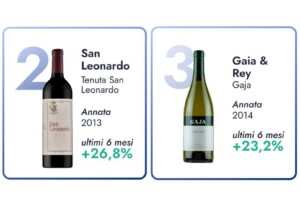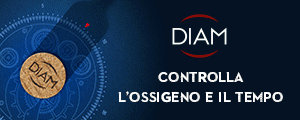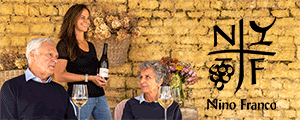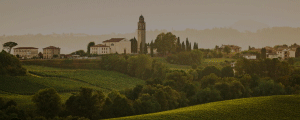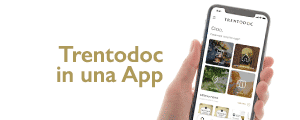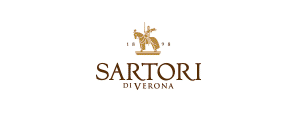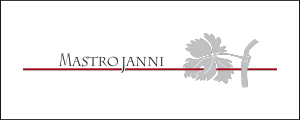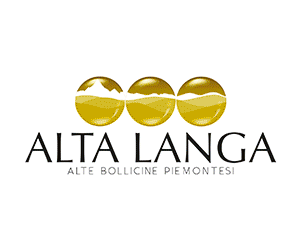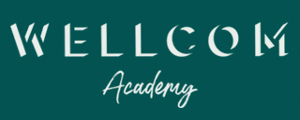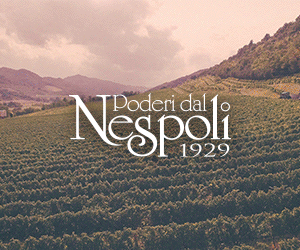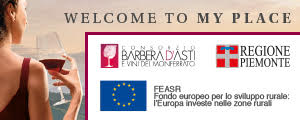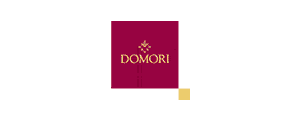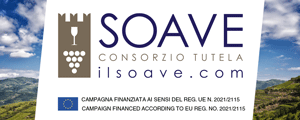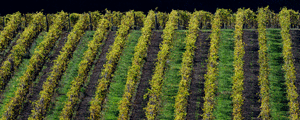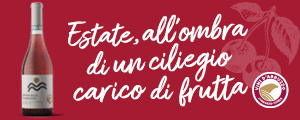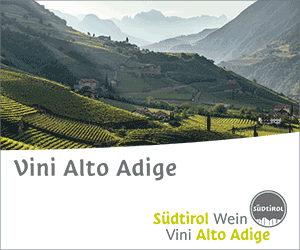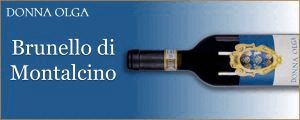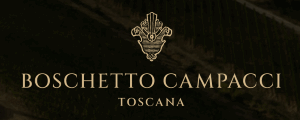Increases in the price lists of Italian wineries are also arriving, after months and months of increases in energy costs and, above all, in “dry” raw materials, glass in the lead, in a phase of the year when contracts with large-scale retail trade are in place. In a panorama as vast and varied as that of Italian wine, where prices range from ex-cellar prices as low as 2 euros per bottle to several tens of euros “per cork”, it’s difficult to pinpoint a precise percentage difference. Even though the most common range appears to be between +8% and +15%. Which, according to many, is less than what would be required to absorb the increase in production costs (which, according to Unione Italiana Vini - Uiv, saw an overall increase of 1.5 billion euros in 2022), with glass, which has practically doubled between the growth of 2022 and the new increases arrived at the beginning of 2023, while cartons for shipping, paper for labels, capsules, stoppers, and transportation are doing little better. In any case, even percentage increases in bottle prices such as those feared have different impacts depending on the variables. They are an enormous problem above all on lower priced wines, where the margin per bottle is represented by a few tens of euro cents, and with a large-scale retail trade, the main recipient of these wines, is reluctant to accept increases that should be fearful (shared with the producers) of seeing a drop in consumption in all that is the “entry-level”. While it is a challenge to manage, it is also an opportunity to gain a position from which to try not to retreat in the future for higher-end products, aimed primarily at catering and hospitality, and where a few euros bottle increase, if well explained, narrated, and motivated, appears to be accepted without difficulty by the market. It is the extreme synthesis picture in a very complicated panorama traced by WineNews, which has reached over 50 different producers on a very hot topic, including cooperatives, small wineries, and private companies that work on important numbers and on different markets for channel and positioning, but also distribution players and supply chain representatives.
If many producers of great value territories and wines that end up primarily in the restaurant and wine bar channel, such as those we’ve heard recently from the various previews linked to Amarone della Valpolicella, (with top management of wineries such as Pasqua, Monte del Frà, Santi del Giv - Gruppo Italiano Vini, Tinazzi, Novaia, Roccolo Grassi, Le Guaite by Noemi and Valentina Cubi), Langhe (with and testimonials from Cordero di Montezemolo, Cascina Chicco, Angelo Negro, Giuseppe Cortese, Vajra, Malvirà, Palladino, Ettore Germano, Adriano Marco and Vittorio, Albino Rocca, Piazzo Commendatore Armando, and Michele Chiarlo), and others, underline how in fact in this segment there is not too much resistance or difficulty, others, more focused on large-scale distribution, or maybe with different product lines that go on multiple channels, providing a more complex picture of the current situation.
Rodolfo Maralli, Sales & Marketing Director of Banfi, a leading company in the region, speak from Montalcino about his company’s product line, which includes the great Brunello di Montalcino as well as wines for mass consumption. “Price increases have always been a part of a company’s life, even though Banfi has always stood out for significantly lower average increases than Istat inflation because we always try to make economies internally. Over the last ten years, the average has been a maximum of 2% per year. Everyone expected more significant increases in 2023, according to the market, sales force, and distributors. Wine has seen massive price increases, primarily in glass, paper, transportation, and energy. As a result, we were forced to return them to the 2023 price list, which is global, the same for the entire world, and we made an increase ranging from 5% to 10%, depending on the product. As a choice, we have tried to increase the prices of mid-range and entry-level products a little less, rather than those of the higher range - explains Maralli - even if at an economic level it would have been more rational to do the opposite. However, we chose to focus on the lower end of the production, which has lower margins. In general, large-scale distribution has set limits and stated that it will not accept large increases, whereas wine bars and restaurants are an exception. Often, the wine shops themselves, as well as the restaurateurs, are small wine producers, so they know it is not a rumor. They are obviously unhappy, but they understand the situation, and according to our agents and distributors, there are no particular negative reactions. On the large-scale distribution front, if we are unable to transfer the cost increase to prices, we should drastically reduce the promotional lever, as is typical for Easter or Christmas promotions. But we’ll see”. From Tuscany to Veneto, where the testimonies of two area reference wineries, in this case, cooperatives, but also with different product lines that go through different channels, arrive. For example, the Valpolicella Negrar winery brings together 700 hectares of vineyards in the Valpolicella Classica area, which are managed by 230 members. “We have been renewing the contracts in recent weeks - explains the general director Daniele Accordini - and we are helping both the catering and the large-scale distribution to absorb them. We are between 8% and 12%, depending on the product, and in addition to the increases in dry materials and energy, we must also manage the increases in bulk wine prices. Amarone, for example, has risen from 7.5 to 11 euros per liter. We achieved the first renewals with some increases with difficulty; the market absorbs them for the time being, but by the end of the year, we expect a -10% drop in sales, because families in general have less disposable income. Catering is expanding, but it is not compensating for the decline in large-scale distribution. The increases that we bring to the price list, however, will not cover the costs, which we hope will start to fall starting from May-June. A few days ago, we had another increase in a glass of +20%, after +55% in 2022. And it’s clear that entry-level wines suffer the most because even 20 cents matters in certain price ranges. Let’s hope that energy prices return to pre-pandemic prices, or at least come close to it. Also because the prices of some dry materials are unjustified today, given that the price of gas has fallen compared to a few months ago. And then - Accordini adds - there is another factor: previously, prices were set annually, even for dry materials; now, quarterly agreements are made, making everything more difficult, also because contracts with large-scale distribution remain annual, and work in an uncertain environment. Let’s hope that the war ends and that this will aid in the return to normalcy because it is difficult to set prices based on expected margins that may be distorted by changes. Abroad - underlines Accordini again - we are doing well in the United States, which absorbs the price increases well, due to the weak euro, while other markets are suffering greatly, such as Germany and the UK, while the surprise is Russia which is increasing a lot, for we did almost +50% in 2022, and many other colleagues in the area also tell me this. An increase that is difficult to explain, unexpected in these conditions, even though we have worked a lot on that country in recent years, before the war”. To sum up, a picture of great uncertainty that comes after difficult years, as recalled by Wolfgang Raifer, director of Cadis1898, as the Cantina di Soave has just been renamed, which brings together 6,400 hectares of vineyards and 2,000 winegrowing members. “The world of wine production found itself faced with an unpredictable situation at the end of 2021, we made the price lists considering the usually reduced increases so that the market could incorporate them without impacting consumption, then everything happened, and we experienced increases in raw materials and costs throughout 2022, and also at the beginning of 2023. Glass also increased by over 100% more than in 2021, and therefore all of this had to be calculated. The 2023 price lists take into account all these increases. This - underlines Raifer - leads to difficulties in relating to the market, which did not expect such strong increases, and is somewhat true for all channels. However, as a percentage of a 10 euro bottle, the increase is modest, while on the first price, there is also talk of 20%. And it’s not easy, because for certain product ranges, unloading them on the final prices for the consumer means losing sales volumes. The supply chain, starting with the winegrowers, who have seen the costs of everything increase, from planting materials to fertilizer, from energy to pesticide products, is between a rock and a hard place, because, on the one hand, there is a market that does not want to accept increases in price lists, on the other hand, producers who have to deal with much higher production costs than a year and a half ago.
To conclude, generally, we cannot say that it is a positive moment for the sector, at least for a main part of it. Consumers became more aware as prices for everything rose, and it is clear that wine, a luxury item, will be affected as well”. The opinion is also confirmed by Enrico Gobino, marketing and communication director of the Argea group, a reality born from the union of two large companies such as Botter and Mondodelvino. “In general, the situation is not simple. Giving precise numbers is still difficult; we come from 2022 which saw volume losses due to increases, particularly in the modern channel. The horeca sector, in which different premium products are sold, with different margins, and which has more passages, increases can digest them better, and the market has reacted well. Furthermore, there is a greater proclivity on the part of consumers to save, and we anticipate a first half in line with the end of 2022. According to Nielsen data, there is a lower proclivity to consume, plans to reduce spending on consumer goods, and wine, a luxury product, is one of the first categories that one is willing to sacrifice, along with eating out”.
To speak, from Sicily, one of the largest cooperatives in the Region, with 6,000 hectares of vineyards and 2,000 members, led by Giuseppe Bursi. “On our horeca line, Mandrarossa, we are making increases of +12/15%, and the agents tell us that it is being accepted without problems. Things are more complicated in large-scale distribution; we are closing contracts now and will see what happens on the market. Everyone recognizes the need for price increases, as the costs of energy, caps, glass, cartons and other items have increased by 20% to 80%. This must be understood by large-scale distribution, but in this channel, even a few cents matter, and we are negotiating these days. We have also decided on the Settesoli line, to restyle the labels and bottles, to slightly improve the quality of the offer in large-scale distribution, and to give a signal of attention to the customer. In Europe, in general, there is less opposition to price increases, there are encouraging signs from all brands”.
If this is the vision of some leading companies, some of the largest consortia of Italian wine are more or less in the same line, with denominations that “make the market” in terms of value and volume. Like Chianti, the largest red wine denomination in Tuscany, with its 14,000 hectares of vineyards, which, in 2022, put 616,506 hectoliters of wine on the market (Avito data): “companies have already made the increases since November 2022 - comments the president of the Consortium Vino Chianti, Giovanni Busi - but the large-scale distribution does not want to hear about them: if we are on the 3-5% level, in some way they accept them, otherwise they don’t. But the problem is that you set a list price, then suddenly raise the price of bottles and so on, making it impossible to plan and move forward. The issue is determining when the rise in production costs, energy prices, and glass, and dry materials will end. Concerning exports, I believe that the problems we face in Italy are not unique; the world is not in a good place right now. The US is doing slightly better as a result of the strong dollar, but it is not shining. If we are talking about 30 euro bottles, a +10/15% increase is absorbed in some way; those who sell at 2.5-3 euro a bottle play on cents, margins are thinner, and a +15% increase is not accepted by anyone. It is a difficult moment that we have to overcome, what helps is that the market continues to turn, the cash flow is maintained and therefore we are on the market”. From Chianti to Chianti Classico, which, by its vocation, with an average of 35-38 million bottles produced per year, is more oriented towards the restaurant and wine bar channel: “the price lists are increasing, and it is done by everyone. In the territory - said the president of the Chianti Classico Consortium, Giovanni Manetti - we are in the order of +7/8%, or in any case no more than 10%. Catering and wine bars are responding well, while there are some more difficulties with large-scale distribution obviously. Abroad, especially in markets such as the USA, which is the most important of all for us, the strong dollar against the euro is helping us at the moment”. From Tuscany to Veneto, and especially on Prosecco Doc (which, in 2021, saw a certified production of 4.7 million hectoliters, data from Valoritalia), the comment of the director of the Consortium Luca Giavi is laconic: “price increases are expected to range between 10% and 15%, and there is little appetite for them across all channels. On the other hand, we have experienced significant cost increases for two consecutive years, beginning in 2022 and continuing into 2023”. Concern also stems from the massive Doc Delle Venezie (almost 24,000 hectares between Veneto, Friuli Venezia Giulia, and Trentino Alto Adige, for 1.6 million hectoliters of wine bottled in 2022), which, as explained by Consortium president Albino Armani, primarily means Pinot Grigio. “There are various aspects to consider: the price of bulk wine has increased by 10-15% on the Chambers of Commerce mercurial between now and 2022, which is a good thing. But there’s also the issue of glass, which has nearly doubled; a Bordeaux bottle now costs +20-25 cents, up from 30-35 cents last year: cost increases on all fronts, including irrigation, treatments, raw materials, and energy, will be impossible to contain. The price lists’ increases that the large-scale distribution expects are +4/5%, while those that would be truly necessary to manage the cost increase would be around +10-15%. It remains to be seen; now that there is a tug-of-war between production and large-scale distribution, let us hope for an intelligent dialectic, given that, on the food front, wine has seen the least amount of shelf price growth in these months. With margins, on entry-level products, we are already at the bone, we cannot go any further. When you go up, in the premium range, in horeca and catering, however, things are simpler. Abroad, the US is holding up, there is renewed purchasing power, and there is a different sentiment than in Europe, where wages are frozen and there are more difficulties”.
In recent days, Vittorio Cino, general manager of Federvini, made a summary of the supply chain. “The world of wine - he said - is resisting the increases it has to undergo, some of which are hardly justified today, such as those on glass. The medium-small producers are the ones most in difficulty, but we must all work together. Wine has increased less than all other products in recent months, but it cannot lose its margins any longer. We need a table between producers and large-scale distribution, everyone must do their part”. A complicated picture, therefore, especially in large-scale distribution. Whose voice is represented, in our overview, by Francesco Scarcelli, Coop Italia Beverage Manager, one of the leaders of the Italian large-scale distribution (with a 2021 turnover of just under 15 billion euros, of which 90% from the food sector). “The wineries are proposing price increases, and we are evaluating how the market is going, which will end in 2022 with a drop in sales in quantity and value (-4.6% on 2022, to 2.8 billion euros, according to Iri data analyzed by WineNews), and, most importantly, with reduced distribution margins, because we are unable to pass everything on to the consumer. Some costs and variables, beginning with energy, appear to be decreasing, so we want to understand what is going on for a moment. We absorbed more inflation last year than we poured into consumption. We have no other margins; any increases will have to be passed on to the consumer, and the direct risk is a drop in wine consumption. This issue is especially true for “entry-level” products, but not only because everyone has less purchasing power. Today wine is not among the first places on the Italian shopping list”.
Copyright © 2000/2024
Contatti: info@winenews.it
Seguici anche su Twitter: @WineNewsIt
Seguici anche su Facebook: @winenewsit
Questo articolo è tratto dall'archivio di WineNews - Tutti i diritti riservati - Copyright © 2000/2024










